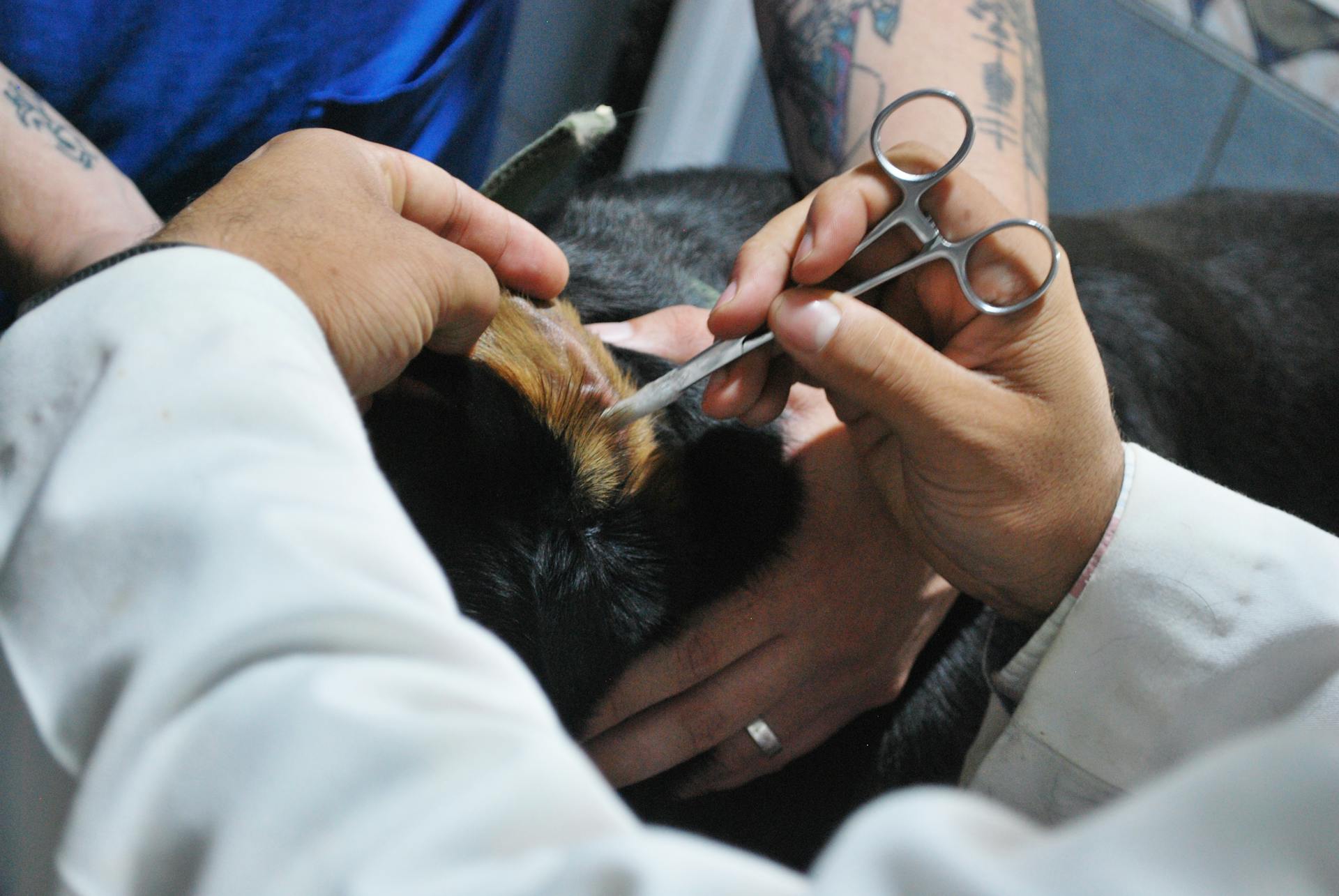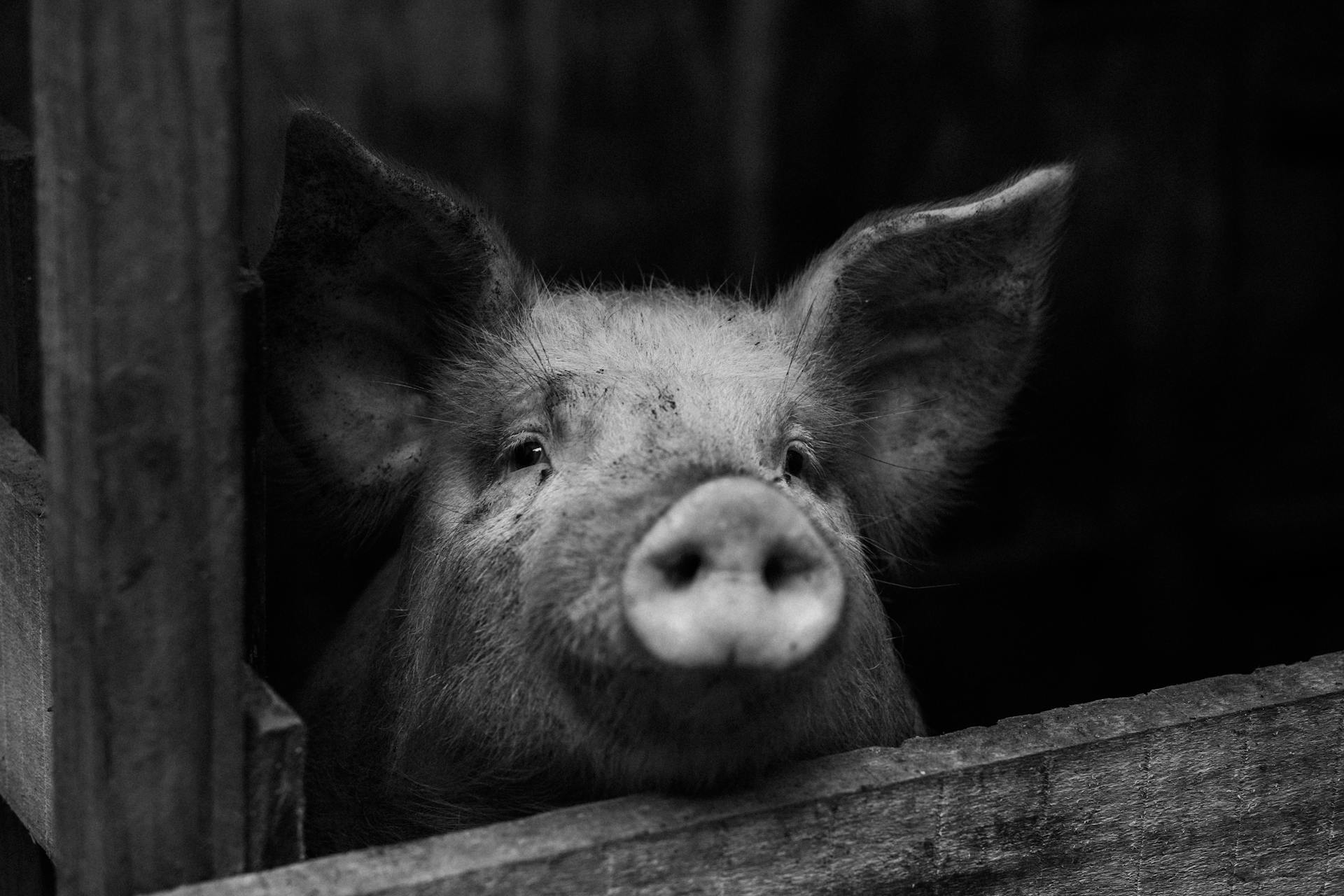
Dog ear cropping is a surgical procedure that's been a topic of debate for many pet owners. The procedure typically involves removing a portion of a dog's ear to create a specific shape or prevent infection.
The American Veterinary Medical Association (AVMA) states that ear cropping is a cosmetic procedure that's not medically necessary. It's often performed on breeds such as Doberman Pinschers, Boxers, and Bull Terriers.
Ear cropping can be done for various reasons, including to prevent ear infections, improve hearing, and enhance a dog's appearance. However, the AVMA and the American Animal Hospital Association (AAHA) discourage ear cropping for non-medical reasons.
What is Ear Cropping?
Ear cropping is a surgical procedure that involves cutting away the outer ear, also known as the pinna, to alter its shape.
This procedure is usually performed on puppies between 6-12 weeks old, as it allows for further development of the ear after surgery and is believed to reduce pain for the animal.
The extent of the procedure varies, with some dogs having nearly the entire outer ear removed, while others have only a small portion cut away.
In some cases, the remaining tissue is positioned with tape and bandages to encourage the appearance of a pointed ear.
A licensed veterinarian is the only one who should perform ear cropping, and it should be done under general anesthesia.
Here are some common breeds that often exhibit cropped ears:
- Doberman Pinschers
- Great Danes
- Mastiffs
- Pit Bull Terriers
Doberman and Great Dane ears are typically left long and pointed, while the "Bully" breeds like Pit Bull Terriers have very little of their outer ear left.
Risks of Ear Cropping
Ear cropping is a surgical procedure that can have serious consequences for a dog's health and well-being. It's painful, as the ear flaps are a sensitive part of the body, and if done illegally by an untrained person, they are unlikely to have access to proper equipment, anaesthetic, or pain relief.
The procedure can cause long-term emotional trauma to the dog, especially when performed on young puppies. They are put through a lot of pain and suffering when they are only two to three months old, and they may suffer from lack of socialisation with other dogs while their ears heal, which can take up to 3 months.
In addition to the physical pain, ear cropping can also limit how a dog communicates with others. Dogs use their ears to tell others how they are feeling, so without them, they can struggle to communicate, which can potentially lead to aggression.
Some dogs may also experience hearing loss due to the mutilation of their ears. Experts agree that some damage is possible, although the extent of the damage is difficult to determine.
Here are some of the potential complications associated with ear cropping:
- Infection
- Normal post-operative pain
- Anesthetic complications
- Emotional trauma
- Hearing loss
- Aggression due to communication difficulties
It's worth noting that the risks associated with ear cropping are well-documented, and veterinary groups such as the American Veterinary Medical Association, the American Animal Hospital Association, and the Canadian Veterinary Medical Association actively oppose the practice.
Why Do People Crop Dogs' Ears?
People crop dogs' ears for a variety of reasons, but the most common one is to achieve a specific appearance. This is often done to make the dog look tougher and more intimidating.
Some breeds, such as Doberman Pinschers and Great Danes, have their ears left long and pointed, while others, like Pit Bull Terriers and Mastiffs, have very little of their outer ear left. This is a result of selective breeding to conform to a specific breed standard.
The practice of ear cropping started in dog fighting circles, where it was believed to prevent dogs from showing submission and to prevent opponents from grabbing their ears. This barbaric practice still exists today in some parts of the world.
In the United States, ear cropping has become the norm for certain breeds, and is sometimes even listed as part of their breed standard. This has led to a lucrative market for dogs with cropped ears, with some breeders making a significant profit from the practice.
Here are some breeds that are commonly associated with ear cropping:
- Doberman Pinschers
- Great Danes
- Mastiffs
- Pit Bull Terriers
It's worth noting that ear cropping is not necessary for a dog's health or well-being, and many experts consider it to be a form of animal cruelty.
Puppy Ear Surgery and Care
Puppy ear surgery is typically performed on puppies between 6 and 12 weeks old, with 10-12 weeks being the ideal age for best results.
The procedure is usually done under general anesthesia, and analgesia (pain medication) is administered to minimize discomfort during and after the surgery. However, it's not always provided, and some puppies may experience post-operative pain and complications.
Ear cropping is a sensitive procedure that requires careful after-care to prevent infection and ensure proper healing. This can include keeping the bandages and supportive "posts" clean and dry, and changing them frequently.
To minimize the risk of complications, it's essential to follow a strict after-care routine, which may include using an Elizabethan collar (cone) to protect the surgery sites and keep the bandages in place.
Here's a brief overview of what to expect during the after-care process:
- Softening scabs with warm compresses and removing them gently
- Keeping the bandages and supportive "posts" clean and dry
- Changing the bandages and "posts" frequently
- Using an Elizabethan collar (cone) to protect the surgery sites
At What Age to Crop a Puppy's Ears?
So you're considering ear cropping for your puppy, but you're not sure at what age to do it. The ideal age for ear cropping depends on the breed and texture of ear cartilage.
Typically, this procedure is recommended at 10-12 weeks for best results. This allows for further development of the ear after surgery.
Most veterinarians will perform ear cropping on puppies who are 6-12 weeks old. This age range is chosen because it allows the puppy to recover from the surgery before they start teething and getting into mischief.
In general, we recommend 10-12 weeks for best results, but it's always best to consult with a licensed veterinarian to determine the ideal age for your dog. They can provide personalized advice based on your puppy's breed and ear type.
Some common breeds that exhibit cropped ears are Doberman Pinschers, Great Danes, Mastiffs, and Pit Bull Terriers.
Intriguing read: Doberman Pinscher Ear Cropping
Puppy Ear Surgery
Ear cropping is a surgical procedure that involves cutting away part of a dog's ear to alter its shape. This is usually done on puppies between 6-12 weeks old, as it allows for further development of the ear after surgery.
The procedure is typically performed by a licensed veterinarian under general anesthesia. However, some unscrupulous breeders may crop ears at home without pain control, which can lead to serious complications.
Ear cropping is not medically necessary and may cause emotional trauma to young puppies. They may suffer from pain, infection, and lack of socialization with other dogs while their ears heal, which can take up to 3 months.
The most common breeds to exhibit cropped ears are Doberman Pinschers, Great Danes, Mastiffs, and Pit Bull Terriers. These breeds often have their ears cropped to meet a cosmetic appearance, sometimes to honor or replicate a putative function.
Here are some potential risks associated with ear cropping:
- Infection
- Pain
- Lack of socialization with other dogs
- Emotional trauma
- Limited communication due to the loss of ear function
- Potential damage to hearing
It's essential to weigh the pros and cons of ear cropping before making a decision. If you're considering this procedure for your puppy, consult with a veterinarian to discuss the potential risks and benefits.
Ear Cropping in the UK and Controversy
In the UK, ear cropping is illegal and considered a form of animal cruelty. The procedure is prohibited by legislation in the country, and dogs with cropped ears are not eligible to compete in kennel club-licensed events.
The Royal Kennel Club will not allow cropped dogs to be shown in their rings, and the procedure is also opposed by veterinary groups. In fact, the Canadian Veterinary Medical Association and the Australian Veterinary Association have also issued statements against ear cropping for cosmetic purposes.
Some countries, like the UK, have banned ear cropping altogether, while others, like the USA, have only restricted the procedure in a few states. Despite the controversy surrounding ear cropping, some breeders continue to perform the procedure on puppies as young as 6-12 weeks old, citing aesthetic reasons.
Here are some breeds that are commonly associated with ear cropping:
- Doberman Pinschers
- Great Danes
- Mastiffs
- Pit Bull Terriers
These breeds have historically had their ears cropped for cosmetic purposes, but it's worth noting that ear cropping is not medically necessary and may harm the dog.
Ear Cropping in the UK
Ear cropping is illegal in the UK, but unfortunately, it's still allowed in some countries, such as the USA.
The law prohibits taking your dog out of the UK to have their ears cropped, but it's still possible to import an ear-cropped dog from a country where it's allowed.
This means that people in the UK are supporting this cruel trade by importing a cropped dog from a country where it's still allowed, or by purchasing an ear-cropped dog from someone in the UK and pretending they were imported.
The PDSA is calling for the Government to make it illegal to import dogs with cropped ears, which would also make it impossible to cover up illegal cropping in this country.
Some common breeds that often have their ears cropped include Doberman Pinschers, Great Danes, Mastiffs, and Pit Bull Terriers.
Expand your knowledge: Dogs Ears Cropped
Cropping is Controversial
Ear cropping is a widely debated topic, with many organizations and individuals speaking out against the practice. The American Veterinary Medical Association and the American Animal Hospital Association have both issued statements opposing ear cropping.
The procedure is not medically necessary and can cause pain and long-term complications for dogs. In fact, the Royal Society for the Prevention of Cruelty to Animals in both Australia and the United Kingdom have taken stands against ear cropping.
Several countries have banned ear cropping, including Australia, most of Europe, and two Canadian provinces. In the United States, only nine states restrict the procedure, but no state completely bans it.
The American Kennel Club (AKC) and some breeders support ear cropping, but most veterinary professional organizations around the world oppose it. The AKC does recognize ear cropping in their breed standards for about 20 breeds of dogs.
Here are some countries and organizations that have taken a stance against ear cropping:
It's worth noting that ear cropping is not required for dog registration in the United States, and some breeders choose not to perform the procedure.
Frequently Asked Questions
What states is ear cropping illegal in?
There are no states in the US where ear cropping is illegal. However, some states have restrictions on who can perform the procedure.
Can you crop an adult dog's ears?
Ear cropping in adult dogs is less common and less successful due to the ears' natural drooping, which can make the procedure more challenging. Success rates decrease significantly after 9-12 weeks of age.
How much is dog ear cropping?
The average cost of dog ear cropping in the US is around $631, plus an additional $107 for recommended blood work. This procedure can vary in cost depending on several factors, including location and veterinarian.
Do dogs ears hurt after being cropped?
Yes, dogs can experience post-operative pain after ear cropping, but complications can also occur, especially if not performed by a veterinarian. This can have long-lasting effects on a puppy's health and well-being.
How painful is ear cropping?
Ear cropping is a painful procedure for dogs, especially when not performed under proper medical conditions. The pain level can be significantly reduced with prescribed anesthesia and pain relief.
Sources
- https://www.dvm360.com/view/veterinary-faq:-ear-cropping-and-otitis-in-dogs
- https://www.petmd.com/dog/general-health/ear-cropping-dogs
- https://www.pdsa.org.uk/pet-help-and-advice/pet-health-hub/other-veterinary-advice/ear-cropping-in-dogs
- https://luvncare.net/ear-cropping/
- https://www.whole-dog-journal.com/health/ear-cropping/
Featured Images: pexels.com


